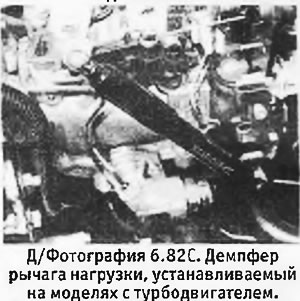Attention: some of the pump adjusting screws and inspection plugs may be sealed during factory assembly. If the machine is still under warranty, these seals cannot be removed. Do not attempt to adjust the timing of the pump unless you have sufficiently accurate gauges.
1. Disconnect the negative cable from the battery.
2. Cover the generator with a plastic bag to protect it from fuel splashes.
3. Engage the handbrake and jack up the front right wheel of the machine until it is off the ground. Support the car and engage 4th or 5th gear. This will allow the engine to be turned using the right front wheel.
4. Disconnect the wire from the glow plug of cylinder No. 4 (from the timing belt side) and turn out the spark plug. Keep in mind that the injection timing is adjusted with piston No. 4 in the TDC position. on the compression stroke (those. piston N 1 is 8 w.m.t. with valves changing their position).
5. You will need 2 dial gauges to check the position of the No. 4 piston and injection pump. You will also need magnetic tripods or brackets to mount the instruments in the right places on the engine.
6. Unscrew and remove the plug on the cylinder head next to the No. 4 injector.
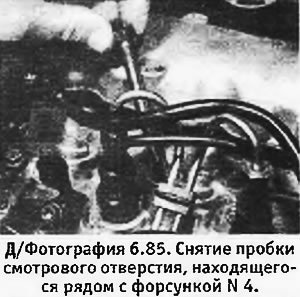
7. Turn the engine forward so that pressure is felt in cylinder No. 4, indicating that piston No. 4 begins to rise on the compression stroke.
8. Install a dial gauge over the inspection hole and attach its probe to the piston.
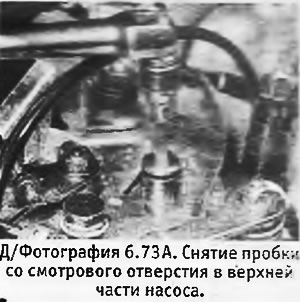 | 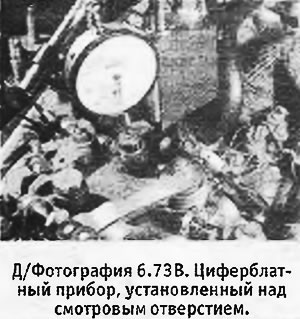 |
9. Turn the engine further forward so that the instrument shows the maximum piston lift No. 4. To check, rotate the engine slightly back and forth so as to exactly reach the top position of the piston, and set the instrument to zero.
10. Unscrew the nuts of the unions and disconnect the fuel pipes of the injectors NN 1 and 2 from the injection pump.
11. Unscrew the plug of the inspection hole at the end of the injection pump (between fuel injector tubes). Be prepared for some fuel to spill.
12. Insert the probe and connect it to the dial gauge, positioned exactly above the hole. Tool used in workshops "Peugeot", shown in D / fig. 3.10.
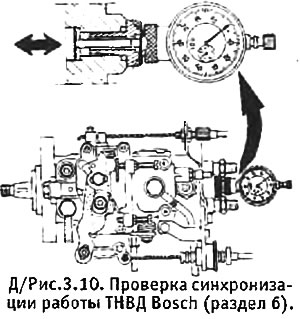
13. Turn the engine back about 1/8 of a turn or so that the No. 4 piston moves 4.0 mm down the cylinder.
14. Bring to zero the dial gauge, standing on the injection pump.
15. Slowly turn the engine forward so that the dial gauge on the high pressure fuel pump shows 0.30 mm and then check that the upper dial gauge shows 0.80±0.03 mm to w.m.t. for models with an engine of 1.7 l or 0.50±0.03 mm to w.m.t. for models with a 1.9 liter engine. If other indications are obtained, do the following.
16. Check the accuracy of zeroing the upper dial gauge by repeating the procedure in paragraph 9.
17. Turn the engine back about 1/8 of a turn or so that the No. 4 piston moves 4.0 mm down the cylinder. Now slowly turn it forward so that the upper dial gauge shows 0.80±0.03 mm BT. for models with an engine of 1.7 l or 0.50±0.03 mm to w.m.t. for models with a 1.9 liter engine.
18. Unscrew the union nuts and disconnect the injector fuel pipes from the injection pump. Loosen the fixing nuts and bolts of the injection pump.
19. Turn the pump housing counterclockwise (when viewed from the side of the fuel injector tubes) and set the dial gauge to zero. Slowly turn the pump clockwise until the dial gauge shows 0.30 mm.
20. Tighten the pump mounting nuts and bolts, making sure that the dial gauge shows no movement.
21. Check the pump timing again as indicated in paragraphs 13-15.
22. Remove the dial gauges and replace the plugs. Connect the fuel pipes of the injectors and tighten the union nuts.
23. Replace the glow plug and connect the wire to it.
24. Lower the machine to the ground and connect the negative cable to the battery. Remove the plastic bag from the generator.
25. Pump fuel into the system (see section 17).
Bosch injection pump on 405 models
1. Read the warning at the beginning of this section and follow the instructions in paragraphs 1-4 (see above). If desired, you can leave the candle in place and instead unscrew and remove the plug of the inspection hole located next to the No. 4 nozzle (see photo).
2. Remove the intermediate radiator (on models with a turbo engine) or air box (on models with a non-turbo engine).
3. Release the clips and remove the front timing belt cover (see pictures).
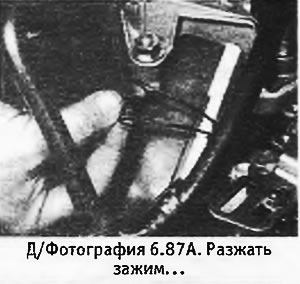 | 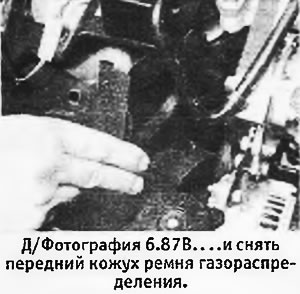 |
4. Note the position of the fuel pipes of the injectors, unscrew the nuts of the fittings and disconnect the pipes from the injection pump and injectors (is done in order to ensure freedom of movement of the injection pump). Be prepared for some fuel to spill when disconnecting the pipes. To create more room to work, disconnect the crankcase ventilation hose from the valve cover. Disconnect also return fuel hoses and valve. Plug the holes formed so that dirt does not get into the system (see pictures).
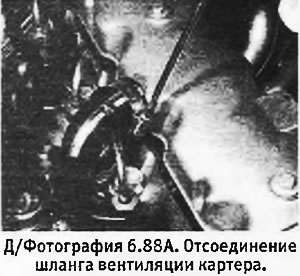 | 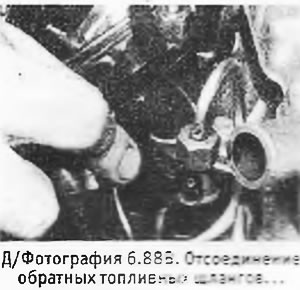 |
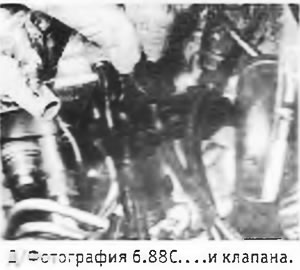 | 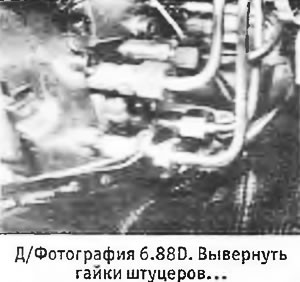 |
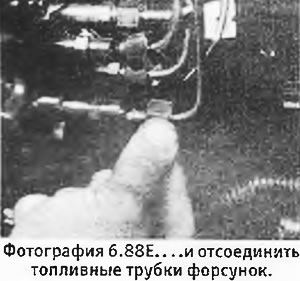 | 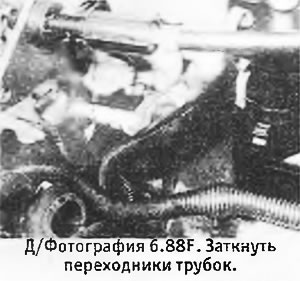 |
5. Unscrew the plug at the end of the injection pump (between fuel injector tubes) photograph).
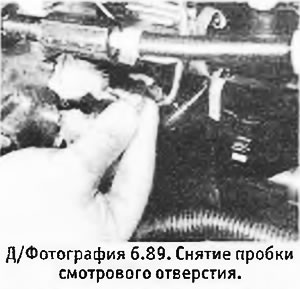
6. Install the dial gauge on the end of the injection pump through the adapter so that it shows 2-3 mm. Depending on the size of the dial gauge, it may be useful to remove the oil separator and tie it aside with a plastic tie.
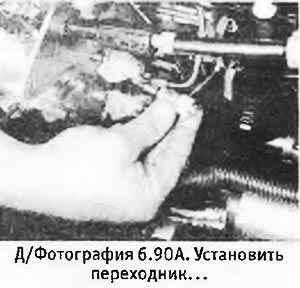 | 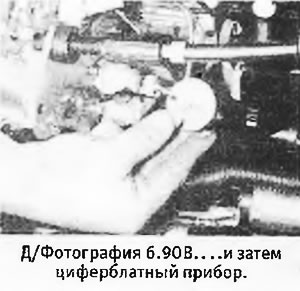 |
7. Turn the engine forward until pressure is felt in cylinder No. 4, indicating that piston No. 4 has begun to rise on the compression stroke. Continue turning the motor in the normal direction of rotation until it is possible to insert an 8 mm bar into the mounting hole so that it fits into the flywheel. At this point, the N4 piston will rise to the T.M.T. on the compression stroke. It is recommended that the bar be bent so that it can pass behind the starter (see photo). Alternatively, you can use a homemade fixture such as the one used to adjust the Lucas CAV / Roto-Diesel injection pump (see d/photo 6.69).
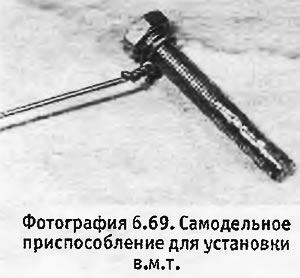 | 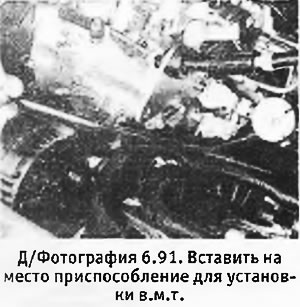 |
8. Remove the device for installing the w.m.t. and turn the crankshaft counterclockwise so that the injection pump plunger is in the n.m.t. (the readings of the dial instrument should stop decreasing). In this position, set the device to zero.
9. Slowly turn the crankshaft in the normal direction of its rotation so that the No. 4 piston is in the TDC position. and a device for installing v.m.t. could be inserted into the flywheel.
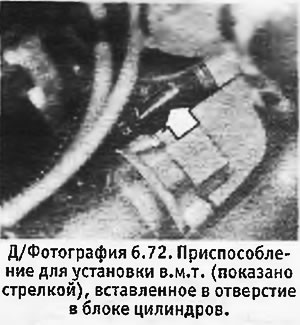
10. Check that the readings on the dial gauge correspond to the value indicated in Specifications for static synchronization of the pump on the engine of the desired brand.
11. If adjustment is necessary, loosen the fixing bolts of the injection pump and turn the pump housing away from the engine as far as it will go (see photo).
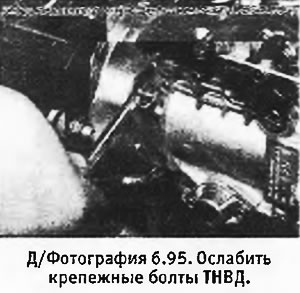
12. Slowly turn the pump body in the opposite direction (towards the engine) so that the dial gauge shows the correct value for static synchronization.
13. Tighten the pump mounting bolts to the correct torque and check the pump timing again.
14. Remove the device for installing the w.m.t. and dial gauge.
15. Install the plug on the end of the injection pump and tighten it securely.
16. Reinstall the fuel injector tubes and tighten the union nuts.
17. Install the front timing belt cover.
18. Install the air distribution box (non-turbo engines) or intermediate radiator (models with turbo engines).
19. Replace and tighten the inspection plug or glow plug (depending on what was filmed).
20. Remove the plastic bag from the generator and connect the negative wire to the battery.
21. Lower the car to the ground.
Bosch injection pump on 405 models
1. Mark the throttle cable 11.0 mm from the end of the sheath (see photo).
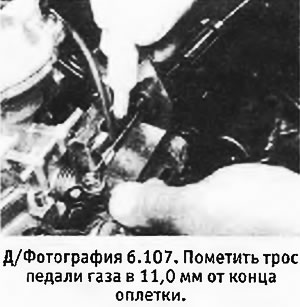
2. Move the load lever so that the mark on the cable matches the end of the sheath and hold it in this position.
3. Loosen the fixing screws of the switch and turn it so that a click is heard, indicating the opening of the internal contacts (see photo).

4. With the switch in this position, tighten the fixing screws and then release the lever.
5. Move the lever lever again and check that the switch contacts actuate at the moment when the mark on the cable coincides with the end of the braid.
Injection pump (405 models with XUD9 engine) - description
1. As follows from Specifications, on the models under consideration, both Lucas and Bosch injection pumps can be installed. Figure 8.20 shows the Bosch injection pump (see pictures).
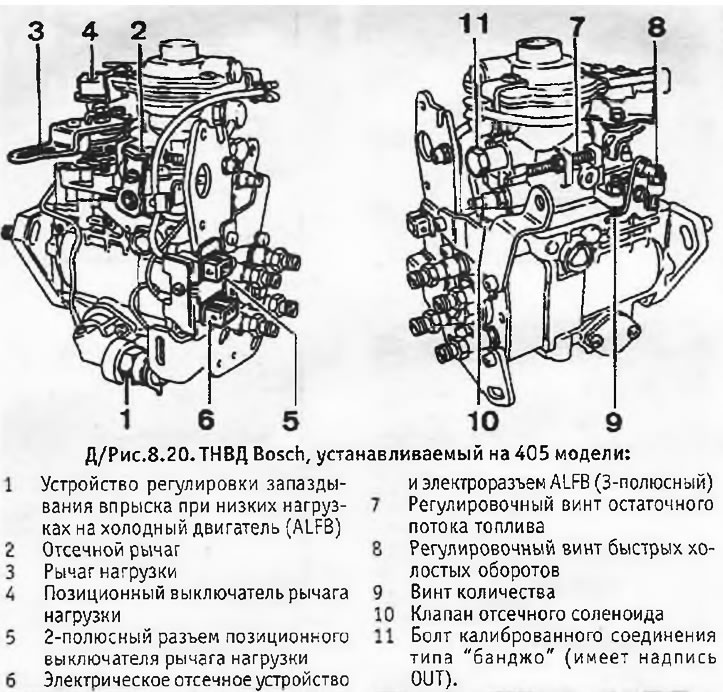
Injection pump (all models) — dynamic control of injection timing
1. The settings for the dynamic control of the injection pump on some models are given in Specifications. However, the dynamic control itself requires the use of expensive equipment, usually not available in the home workshop. The adjustment procedure varies depending on the type of equipment used, so the manufacturer's instructions must be strictly followed in each case. Keep in mind that most dynamic testers give readings accurate to within±2°.
2. Dynamic control must be carried out within the limits dictated by the equipment used. If the results of dynamic control look unsatisfactory, the matter can only be corrected by static control of the pump.
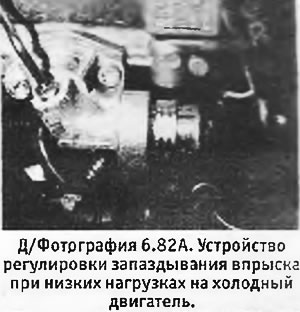 | 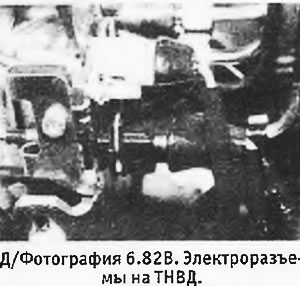 |
